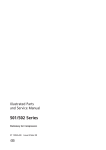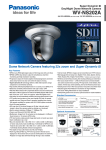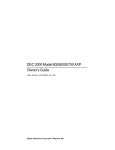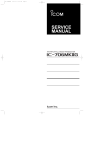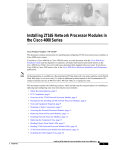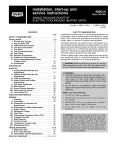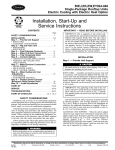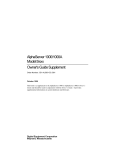Download Digital 900 AXP Technical data
Transcript
DEC 3000 Models 700 AXP and 900 AXP Service/Upgrade Information Addendum Order Number: EK−FLSPC−AD. A01 Digital Equipment Corporation Maynard, Massachusetts June 1994 The information in this document is subject to change without notice and should not be construed as a commitment by Digital Equipment Corporation. Digital Equipment Corporation assumes no responsibility for any errors that may appear in this document. The software described in this document is furnished under a license and may be used or copied only in accordance with the terms of such license. Restricted Rights: Use, duplication, or disclosure by the U.S. Government is subject to restrictions as set forth in subparagraph (c)(1)(ii) of the Rights in Technical Data and Computer Software clause at DFARS 252.227-7013. © Digital Equipment Corporation 1994. All Rights Reserved. Printed in U.S.A. The postpaid Reader's Comments form at the end of this document request your critical evaluation to assist in preparing future documentation. The following are trademarks of Digital Equipment Corporation: Alpha AXP, AXP, DEC, DECchip 21064A, DECconnect, DECnet, Digital, AXP, RRD42, RRD43, RX26, RZ, TURBOchannel, ULTRIX, VAX, VAXstation, VMS, and the DIGITAL logo. FCC Notice: This equipment has been tested and found to comply with the limits for a Class A digital device, pursuant to Part 15 of the FCC Rules. These limits are designed to provide reasonable protection against harmful interference when the equipment is operated in a commercial environment. This equipment generates, uses, and can radiate radio frequency energy and, if not installed and used in accordance with the instruction manual, may cause harmful interference to radio communications. Operation of this equipment in a residential area is likely to cause harmful interference, in which case users will be required to correct the interference at their own expense. S2566 Contents About This Document......................................................................................................... vi Purpose........................................................................................................................ vi Audience ..................................................................................................................... vi Structure ..................................................................................................................... vii Related Documentation................................................................................................ ix Digital Support Centers ....................................................................................................... x Availability................................................................................................................... x Contact Numbers .......................................................................................................... x System Overview and Updates................................................................. 1-1 Overview................................................................................................................................. 1-1 Introduction ............................................................................................................... 1-1 Parts Breakdown...................................................................................................................... 1-2 Parts Breakdown Model 700 ............................................................................................. 1-2 Parts Breakdown Model 900 ............................................................................................. 1-3 Model 900 ................................................................................................................. 1-4 LED Codes.............................................................................................................................. 1-5 Serial ROM LED Codes ................................................................................................... 1-6 ASIC LED Codes ............................................................................................................. 1-8 iii Memory LED Codes....................................................................................................... 1-10 NVR LED Codes............................................................................................................ 1-11 SCC LED Codes............................................................................................................. 1-12 NI LED Codes................................................................................................................ 1-13 ISDN LED Codes ........................................................................................................... 1-15 SCSI LED Codes............................................................................................................ 1-16 Console LED Codes ....................................................................................................... 1-19 MIPS Emulator LEDs..................................................................................................... 1-20 Memory LED Diagnostic Codes ..................................................................................... 1-21 System Upgrade Information ....................................................................2-1 Upgrading from Model 600 to Model 700......................................................................... 2-3 Procedure 1................................................................................................................ 2-3 Procedure 2................................................................................................................ 2-4 Procedure 3................................................................................................................ 2-5 Procedure 4................................................................................................................ 2-5 Upgrading from Model 800 to Model 900......................................................................... 2-6 Procedure 1................................................................................................................ 2-6 Procedure 2................................................................................................................ 2-7 Procedure 3................................................................................................................ 2-7 Procedure 4................................................................................................................ 2-8 Procedure 5.............................................................................................................. 2-11 Table 1 Conventions iv viii Table 2 Reference Documentation ix Table 3 Telephone Numbers of Digital Support Centers xi Table 1-1 Serial ROM LED Codes 1-6 Table 1-2 Serial ROM LED Codes Action Table 1-7 Table 1-3 ASIC LED Codes 1-8 Table 1-4 ASIC LED Codes Action Table 1-8 Table 1-5 Memory LED Codes 1-10 Table 1-6 NVR LED Codes 1-11 Table 1-7 NVR LED Codes Action Table 1-11 Table 1-8 SCC LED Codes 1-12 Table 1-9 SCC LED Codes Action Table 1-13 Table 1-10 NI LED Codes 1-14 Table 1-11 NI LED Codes Action Table 1-14 Table 1-12 ISDN LED Codes 1-15 Table 1-13 ISDN LED Codes Action Table 1-16 Table 1-14 SCSI LED 1-17 Table 1-15 SCSI LED Codes Action Table 1-18 Table 1-16 Console LED Codes 1-19 Table 1-17 Console LED Codes Action Table 1-20 Table 1-18 MIPS Emulator Codes 1-20 Table 2-1 Upgrade Kits 2-1 Table 2-2 Upgrade Parts List 2-2 v Preface About This Document Purpose This addendum provides information for servicing the DEC 3000 Model 700 AXP and DEC 3000 Model 900 AXP systems. The information provided in this document is in addition to the service information provided in the DEC 3000 Models 600/600S AXP and 800/800S AXP Service Information manual. An illustration of the parts breakdown is included for easy location of all part numbers. This addendum also includes updated LED error codes and information for DEC 3000 upgrades. Audience This addendum is a support and reference document for Digital services personnel who perform maintenance work on the DEC 3000 Model 700 AXP and DEC 3000 Model 900 AXP systems. It is also intended for Digital customers who have a self-maintenance agreement with Digital. vii Structure This addendum consists of the following two chapters: • Chapter 1 includes updates to Chapter 5 of the DEC 3000 Models 600/600S AXP and 800/800S AXP Service Information manual. • Chapter 2 covers upgrading the DEC 3000 Model 600 to 700 and Model 800 to 900. Table 1 Conventions The following conventions are used in this addendum: Conventions viii Meaning Note Provides general information. Caution Provides information that prevents damage to equipment and software. Warning Provides information to prevent personal injury. Related Documentation The documents listed in Table 2 provide additional information about the DEC 3000 Model 700 AXP and DEC 3000 Model 900 AXP systems. Table 2 Reference Documentation Document Order Number DEC 3000 Model 600/600S AXP and 800/800S AXP Service Information EK−FLSPC−SV DEC 3000 Model 600/600S/700 AXP Owner's Guide EK−SNDPL−OG DEC 3000 Model 600/700 AXP Setting Up Your Workstation EK−SNDWS−QC DEC 3000 Model 600S AXP Setting Up Your Server EK−SNDSR−QC DEC 3000 Model 600/600S AXP Technical Summary DEC 3000 Model 600/600S/700 AXP Options Guide EK−SNDPR−TM EK−SNDPL−OP OpenVMS Factory Installed Software User Card EK−A0377−UG Guide to Installing DEC OSF/1 EK−SFFIS−UG DEC 3000 Model 600/600S AXP Floor Stand Installation Card EK−SNDPR−QC TURBOchannel Expander Box Owner's Guide EK−TRBXT−IN Alpha AXP Systems Firmware Release Notes DEC 3000 Model 800/800S/900 AXP Owner's Guide AA−PW8YH−TE DEC 3000 Model 800/800S/900 AXP Options Guide EK−FLMUL−OP DEC 3000 Model 800/900 AXP Quick Installation Card EK−FLMUL−QC DEC 3000 Model 800S/900 AXP Quick Installation Card EK−FLMSR−QC DEC 3000 Model 800/800S AXP Technical Summary EC−N0094−51 EK−FLMUL−OG ix Digital Support Centers Availability Digital service representatives are available at Digital support centers for on-site warranty and service contract customers. If you do not currently receive this support but would like to, please contact either a Digital support center listed in the following table, or your local Digital office. Contact Numbers Table 4 lists several telephone numbers for Digital support centers worldwide. If a Digital services number is not listed for your area, please contact your local Digital office for assistance. x Table 3 Telephone Numbers of Digital Support Centers Country United States Canada Canada (Quebec) United Kingdom France Germany Telephone Number 1-800-354-9000 1-800-267-5251 1-800-267-2603 [44]256 59200 [33]92955111 [49]-(89)-95913218 xi Overview and Updates 1 System Overview and Updates Overview Introduction The DEC 3000 Model 700 (desktop) and Model 900 (deskside) AXP systems are high performance workstations. These systems incorporate Digital's DECchip 21064A RISC processors, which are part of the Alpha AXP architecture. 1-1 Overview and Updates Parts Breakdown Parts Breakdown Model 700 All of the parts listed for the Model 700 are interchangeable with the Model 600 unless denoted otherwise. TURBOchannel Option MMB with SIMMS MMB 54-21815-01 32MB MS15-CA 64MB MS15-DA 128MB MS15-EA Removable Media RRD42-HM RRD43-HM TZK11-FM RX26-FH (3.5") IO Module 54-21813-02 Drive Bracket 74-44841-01 Power Supply H7816-AA *System Module 54-23153-05 Fixed Disks RZ26L-EJ RZ28-EJ Drive Plate Assembly 70-30262-01 Chassis BA47A MLO-012780 ∗ The system module is unique to the Model 700. 1-2 Overview and Updates Parts Breakdown Model 900 All of the parts listed for the Model 900 are interchangeable with the Model 800 unless denoted otherwise. Rear Bezel 74-44072-01 Lights and Switch Module (LSM) 54-21145-02 Audio Assembly 70-29562-01 Fixed DisksRZ24L-E RZ25-E RZ25L-EJ RZ26-EJ RZ26L-EJ RZ28-EJ IO Module 54-21147-02 Front Bezel 74-43830-01 Fan Assembly 12-23609-12 MLO-012781 1-3 Overview and Updates Model 900 Top Cover 70-30266-01 MMB with SIMMS MMB 54-21141-01 32MB MS15-CA 64MB MS15-DA 128MB MS15-EA 256MB MS15-FA Right Side Panel 70-29563-01 Regulator Module 54-23128-01 **Impingement Fan 70-30888-01 *System Module 54-23153-04 Power Supply H7883-YA Left Side Panel 70-29563-01 Removable Media RRD43-HM RX26-FT (3.5") TLZ07-MF See Chapter 2 for the following: Ferrite Bead (16-25105-18) Impingement Fan Regulator Cable (17-03815-01) Regulator Fan Sense Cable (17-03816-02) MLO-012782 ∗ The system module is unique to the Model 900. ∗∗ The impingement fan is new and only used on the Model 900. 1-4 Overview and Updates LED Codes The LED code information in Chapter 5 (pages 5-2 −5-14) of the DEC 3000 Models 600/600S AXP and 800/800S AXP Service Information has been corrected on pages 1-5− 1-19 of this addendum. These corrections supersede the LED information in Chapter 5 of DEC 3000 Models 600/600S AXP and 800/800S AXP Service Information. If the system enters console mode, execute diagnostics and interpret the error information using the SHOW ERROR command described in Chapters 4 and 14 of the DEC 3000 Models 600/600S AXP and 800/800 AXP Service Information (EK−FLSPC−SV). An LED display indicates the diagnostic currently being executed when the unit is first powered on. If an error occurs before the system enters console mode, the failed test is identified on this display. On the Model 900 system, this display consists of two LEDs on the front of the unit, which represent two hexadecimal digits. On the Model 700 system, this display consists of a row of eight LEDs on the rear of the unit. The eight LEDs correspond to eight binary bits, which can be grouped to form two four−bit bytes. Use the diagnostic LEDs to help diagnose problems when the system is unable to set up the console. This portion of the testing does not appear on the monitor. __________________________ Note_____________________________ In the tables containing LED codes, • indicates that an LED is on; o indicates that an LED is off. All changes from Chapter 5 of the service information manual appear in bold within the tables. ____________________________________________________________ 1-5 Overview and Updates Serial ROM LED Codes Apply the solutions listed in Table 1-2 as indicated in Table 1-1. Table 1-1 Serial ROM LED Codes LED Display Hex Code Solution 1 •••••••• •••••••o ••••••o• ••••••oo •••••o•• •••••o•o •••••oo• •••••ooo ••••o••• ••••o••o ••••o•o• ••••o•oo ••••oo•• ••••oo•o ••••ooo• ••••oooo oo•ooooo FF FE FD FC FB FA F9 F8 F7 F6 F5 F4 F3 F2 F1 F0 20 2 2 2 2 ∗ 2 2 2 2 ∗ ∗ 1 ∗ 1 ∗ 1 2 ∗ Informational only, never fails here. 1-6 Solution2 Solution 3 3 3 3 3 5 5 5 5 3 3 3 3 4 4 4 5 Overview and Updates Table 1-2 Serial ROM LED Codes Action Table Solution Action 1 Ensure that a good connection is made between the system module and I/O module. Ensure that all memory SIMMs are properly installed. It may be necessary to reseat memory SIMMs. Replace system module. Replace I/O module Replace MMB/SIMMs. 2 3 4 5 1-7 Overview and Updates ASIC LED Codes The ASIC LED codes represent continued power-on testing. If an error occurs during this testing sequence, a hexadecimal code appears with FRU and error code information on the monitor screen. If the system does not enter console mode (>>>) , or hex code DD is not displayed on the LEDs, then use Tables 1-3 and 1-4 to isolate the failed FRU. Table 1-3 ASIC LED Codes LED Display oo••oooo oo••ooo• oo••oo•o oo••oo•• oo••o•oo oo••o•o• oo••o••o oo••o••• oo•••ooo oo•••oo• oo•••o•o oo••••••• Hex Code Solution 1 Solution 2 30 31 32 33 34 35 36 37 38 39 3A 3F 2 2 2 2 2 2 2 2 2 2 2 1 1 1 1 1 1 1 1 1 1 1 None: All tests Passed Solution 3 3∗ 3 3 3 3 3 3 3 3 3 3 ∗ If replacing the system module fixes the system, then try reinstalling the original I/O module. 1-8 Overview and Updates Table 1-4 ASIC LED Codes Action Table Step Action 1 2 3 Reseat I/O module. Replace I/O module. Replace system module. 1-9 Overview and Updates Memory LED Codes The memory LED codes represent continued power-on testing. If an error occurs during this testing sequence, a hexadecimal code appears with FRU and error code information on the monitor screen. If the system does not enter console mode (>>>) or hex code DD is not displayed on the LEDs, then use table 1-5 to isolate the failed FRU.. Table 1-5 Memory LED Codes 1-10 LED Display Hex Code oo•ooooo oo•oooo• oo•ooo•o oo•ooo•• oo•oo•oo oo•oo•o• oo••oo•••o oo••oo•••• 20 21 22 23 24 25 26 27 oo••o••ooo oo•o•oo• oo•o•o•o oo•o•o•• oo•o••oo oo•o••o• oo•o•••o oo•o•••• 28 29 2A 2B 2C 2D 2E 2F Description Machine Check CELL Fill mem with test pattern data CELL Forward RD/Compare/Complement/Wr CELL Reverse RD/Compare/Complement/Wr ADDR Fill mem with addresses as data Refresh test in progress Addr Read/Compare data = address BITS Fill mem with a pattern of 1's in a field of 0's BITS Read/Compare data = pattern Reserved Reserved LLSC load-locked/store-conditional tests B-cache tag parity detection ECC detection Reserved Clear memory to zeros Overview and Updates NVR LED Codes The NVR LED codes represent continued power-on testing. If an error occurs during this testing sequence, a hexadecimal code appears with FRU and error code information on the monitor screen. If the system does not enter console mode (>>>) or the hex code DD is not displayed on the LEDs, use Tables 1-6 and 1-7 to isolate the failed FRU. Table 1-6 NVR LED Codes LED Display oo•••o•o oo•••o•• oo••••oo oo••••o• oo•••••o oo••••••• Hex Code 3A 3B 3C 3D 3E 3F Solution 1 1 1 1 1 1 All Tests Passed Solution 2 2 2 2 2 2 Table 1-7 NVR LED Codes Action Table Step Action 1 2 Reseat I/O module Replace I/O module 1-11 Overview and Updates SCC LED Codes The SCC LED codes represent continued power-on and extended self-test testing. If an error occurs during this testing sequence, a hexadecimal code appears with FRU and error code information on the monitor screen. If the system does not enter console mode (>>>) or if hex code DD is not displayed on the LEDs, use Tables 1-8 and 1-9 to isolate the failed FRU. Table 1-8 SCC LED Codes LED Display Hex Code Solution 1 o•oooooo o•ooooo• o•oooo•o o•oooo•• o•ooo•oo o•ooo•o• o•ooo••o o•ooo••• o•oo•ooo o•oo•oo• o•oo•o•o o•oo•o•• o•oo••oo o•oo••o• o•oo•••o o•oo•••• 40 41 42 43 44 45 46 47 48 49 4A 4B 4C 4D 4E 4F ∗ ∗ 1 2 1 1 1 4 3 Reserved Reserved Reserved Reserved Reserved Reserved ∗ Solution 2 5 5 5 5 5 7 6 Solution 3 5∗∗ 5 ∗ Informational only − never fails here. ∗∗ If replacing the I/O module fixes the system, then try reinstalling the original keyboard. 1-12 Overview and Updates Table 1-9 SCC LED Codes Action Table Step 1 2 3 4 5 6 7 Action Reseat I/O module Reseat modem loopback (only in service mode). Reseat mouse connection. Reseat keyboard connection Replace I/O module. Replace mouse Replace keyboard 1-13 Overview and Updates NI LED Codes The NI LED codes represent continued power-on and extended self-test testing. If an error occurs during this testing sequence, then a hexadecimal code appears with FRU and error code information on the monitor screen. If the system does not enter console mode (>>>) or if hex code DD is not displayed on the LEDs, then use Tables 1-10 and 1-11 to isolate the failed FRU. Table 1-10 NI LED Codes LED Display o•o•oooo o•o•ooo• o•o•oo•o o•o•oo•• o•o•o•oo o•o•o•o• o•o•o••o o•o•o••• o•o••ooo o•o••oo• o•o••o•o o•o••o•• o•o•••oo o•o•••o• o•o••••o o••o•••••• Hex Code 50 51 52 53 54 55 56 57 58 59 5A 5B 5C 5D 5E 5F Solution 1 1 1 1 1 1 1 1 1 1 1 1 1 1 1 1 None: All Tests Passed Table 1-11 NI LED Codes Action Table Step 1 2 1-14 Action Reseat I/O module and system module. Replace I/O module. Solution 2 2 2 2 2 2 2 2 2 2 2 2 2 2 2 2 Overview and Updates ISDN LED Codes The ISDN LED codes represent continued power-on and extended self-test testing. If an error occurs during this testing sequence, a hexadecimal code appears with FRU and error code information on the monitor screen. If the system does not enter console mode (>>>) or if hex code DD is not displayed on the LEDs, use Tables 1-12 and 1-13 to isolate the failed FRU. Table 1-12 ISDN LED Codes LED Display Hex Code Solution 1 Solution 2 o•••oooo o•••ooo• 70 71 1 1,3,4 o•••oo•o o•••oo•• o•••o•oo o•••o•o• o••••o•••• o•••••ooo o•••••oo•• o•••••••• 72 73 74 75 77 78 79 7F 1 1 1 1 3,4,1 3,4,1 3,4,1 None: All Tests Passed 2 2,5 (M800/M800S/M900) 2 2 2 2 2 2 2 1-15 Overview and Updates Table 1-13 ISDN LED Codes Action Table Step 1 2 3 4 5 Action Reseat I/O module and system module. Replace I/O module. Make sure a handset is connected. Make sure that the audio module cable is connected to the I/O module. Replace Audio Module (M800/M800S/M900) SCSI LED Codes The SCSI LED codes represent continued power-on and extended self-test testing. If an error occurs during this testing sequence, a hexadecimal code appears with FRU and error code information on the monitor screen. If the system does not enter console mode (>>>) or if hex code DD is not displayed on the LEDs, use Tables 1-14 and 1-15 to isolate the failed FRU. 1-16 Overview and Updates Table 1-14 SCSI LED Codes LED Display Hex Code Solution 1 o••ooooo o••oooo• o••ooo•o o••ooo•• o••oo•oo o••oo•o• o••oo••o o••oo••• o••o•ooo o••o•oo• o••o•o•o o••o•o•• o••o••oo o••o••o• o••o•••o o•••o••••• 60 61 62 63 64 65 66 67 68 69 6A 6B 6C 6D 6E 6F 1 1 1 1, then 3 1, then 3 1, then 3 ∗ ∗ ∗ ∗ ∗ ∗ ∗ ∗ ∗ None: All Tests Passed Solution 2 2 2 2 2, then 4 2, then 4 2, 4, then 5 ∗ Reserved for future use. 1-17 Overview and Updates Table 1-15 SCSI LED Codes Action Table Step 1 2 3 4 5 1-18 Action Reseat I/O module and system module. Replace I/O module. Check SCSI cables and SCSI ID. Replace the drive. All removable disk devices must have media installed. Overview and Updates Console LED Codes The last testing sequence before entering the console program now begins. If this is successful, the LEDs should display hex code DD for console entry. If the system does not enter console mode, use Tables 1-16 and 1-17 to isolate the failed FRU. No information appears other than the console (>>>) prompt or the DD hex code to indicate that the console mode has been entered. Table 1-16 Console LED Codes LED Display Hex Code Solution 1 •••o•••• •••o•••o •••o••o• •••o••oo •••o•o•• •••o•o•o •••o•oo• •••o•ooo •••oo••• •••oo••o •••oo•o• •••oo•oo •••ooo•• •••ooo•o •••oooo• •••ooooo ••o••••• ••o••••o ••o•••o• oooooooo EF EE ED EC EB EA E9 E8 E7 E6 E5 E4 E3 E2 E1 E0 DF DE DD 00 ∗ ∗ ∗ 1 1 1 1 1 1 1 1 1 1 1 1 ∗ 1 1 Console entry >>> Solution 2 2 2 2 2 2 2 2 2 2 2 2 2 2 2 ∗∗ ∗ Informational only − never fails here. ∗∗ Console is about to be exited. 1-19 Overview and Updates Table 1-17 Console LED Codes Action Table Step 1 2 Action Replace I/O module. Replace system module. MIPS Emulator LEDs The following LED codes represent MIPS emulator diagnostic tests. If an error occurs during one of the tests, the screen displays a FRU code and error code. Table 1-18 MIPS Emulator Codes 1-20 LED Display Hex Code •oo••oooo •oo••ooo•• •oo••oo••o 90 91 92 •oo••oo••• •oo••o••oo •oo••o••o•• •oo••o•••o •oo••o•••• •oo•••ooo •oo•••oo•• •oo•••o••o 93 94 95 96 97 98 99 9A Description MIPS Emulator running with no errors. Invalid REX command entered. Unsupported REX command entered. Supported in REX but not supported by emulator. Bad address detected by the emulator. ROM not found in this slot. ROM object not found. Cannot load ROM object. Invalid MIPS-I instruction detected. ROM object called halt. Invalid callback called. Unsupported callback called; callback currently not in this release. Overview and Updates Memory LED Diagnostic Codes The following memory LED code table supersedes and corrects the table on page 14−4 of the DEC 3000 Models 600/600S AXP and 800/800S AXP Service Information manual. The following LED codes represent memory diagnostic tests. If an error occurs during one of these tests, the screen displays an FRU code and error code. Table 1-19 Memory LED Diagnostic Codes Hex Code Description 20 21 22 23 24 25 26 27 28 29 2A 2B 2C 2D 2E 2F Machine Check CELL Fill mem with test Pattern data CELL Forward RD/Compare/Complement/Wr CELL Reverse RD/Compare/Complement/Wr ADDR Fill mem with addresses as data Refresh test in progress ADDR Read/Compare data = address BITS Fill mem with a pattern of 1's in a field of 0's BITS Read/Compare data = pattern Reserved Reserved LLSC load-locked/store-conditional tests B-cache tag parity detection ECC detection Reserved Clear memory to zeros 1-21 Overview and Updates 2 System Upgrade Information This chapter contains information for upgrading the DEC 3000 Model 600 to a Model 700 and the DEC 3000 Model 800 to a Model 900. You will need to use this chapter and the DEC 3000 Models 600/600S AXP and 800/800S AXP Service Information manual (EK− FLSPC−SV) to upgrade your system. Table 2-1 Upgrade Kits Model 700 900 Part Number PE44U−AA/BA PE54U−AA/BA __________________________ Note_____________________________ See Chapters 3 and 8 of the DEC 3000 Models 600/600S AXP and 800/800S AXP Service Information manual for removal and replacement procedures. ____________________________________________________________ 2-1 Overview and Updates Table 2-2 Upgrade Parts List The following table lists of all the parts contained in the update kits: Model No. Model 700 Model 900 2-2 Parts description Part Number CPU module 54−23153−05 Label, product conversion 36−15946−01 Comments VMS−LIC. PAK DEC 3000 700 75−00023−15 BA version only OSF−LIC. PAK DEC 3000 700 75−00023−16 AA version only Upgrade Information Sheet EK−D3AXP−IN Alpha AXP FW/Console Kit QZ−003AA−E8 CPU module 54−23153−04 Label, product conversion 36−15946−01 VMS−LIC. PAK DEC 3000 900 75−00022−15 BA version only OSF−LIC. PAK DEC 3000 900 75−00022−16 AA version only Wire harness assembly 17−03815−01 Wire harness assembly 17−03816−02 Fan bracket assembly 70−30888−01 Screw, sems 6-32 pan 90−00049−01 Screw, mach 6-32 flt 90−06039−02 Clip, cable 12−37200−02 Ferrite bead assembly 16−25105−18 Alpha AXP FW/Console Kit QZ−003AA−E8 Upgrade Information Sheet EK−D3AXP−IN qty 2 qty 2 Overview and Updates Upgrading from Model 600 to Model 700 __________________________ Note_____________________________ See Chapters 3 and 8 of the DEC 3000 Models 600/600S AXP and 800/800S AXP Service Information manual for removal and replacement procedures. ____________________________________________________________ Procedure 1 1. Check all field blitzes and verify that any needed field notices have been installed in the system. 2. If the system is not already operating with OSF Version 2.1 or later, or VMS Version 6.1 or later, then back up all the files. 3. Ensure that the customer has all required Base operating systems and layered product licenses (PAKS) to support installation of OSF Version 2.1 or later or VMS Version 6.1 or later. 4. Shut down the operating system and upgrade your system firmware to Version 3.3 or later by following the procedure in the firmware release notes. 5. Power up the system and verify that the system firmware has been properly updated. 2-3 Overview and Updates Procedure 2 1. Remove the disk-tray assembly. 2. Remove the TURBOchannel option cards, and take note of the slot number that each card was installed in. 3. Remove the 4 MMB modules (leaving SIMM cards installed). 4. Remove the disk-tray supports. 5. Remove the I/O module. 6. Remove the system module. __________________________ Note _____________________________ Save the nylon washers for remounting the system module. ____________________________________________________________ 2-4 Overview and Updates Procedure 3 1. Install the Model 700 system module. _________________________ Caution ___________________________ Use the nylon washers saved previously when you install the new system module. Place the two washers on the two most centered screws. Failure to use nylon washers will result in an inoperable system. ____________________________________________________________ 2. Reassemble the system to its original configuration by performing the reverse of procedure 2. Procedure 4 1. Power up the system and verify that the system powers up correctly. 2. Complete the assembly of the system enclosure. 3. Run all extended power up self−tests. 3. Install the new OSF/1 Version 2.1 or later, or VMS Version 6.1 kit or later (if not already done) and restore all of the customer's files. 4. Package the old system module for return to Digital. Use the packaging from the new system module. 2-5 Overview and Updates Upgrading from Model 800 to Model 900 __________________________ Note _____________________________ See Chapters 3 and 8 of the DEC 3000 Models 600/600S AXP and 800/800S AXP Service Information manual for removal and replacement procedures. ____________________________________________________________ Procedure 1 1. Check all field blitzes and verify that any needed field notices have been installed in the system. 2-6 2. If the system is not already operating with OSF Version 2.1 or later, or VMS Version 6.1 or later, then back up all the files. 3. Ensure that the customer has all required Base operating systems and layered product licenses (PAKS) to support installation of OSF Version 2.1 or greater or VMS Version 6.1 or later. 4. Shut down the operating system and upgrade your system firmware to Version 4.0 or later by following the procedure in the firmware release notes. 5. Power up the system and verify that the system firmware has been properly updated. Overview and Updates Procedure 2 1. Remove the TURBOchannel option cards, and take note of the slot number that each card was installed in. 2. Remove the 4 MMB modules (leaving SIMM cards installed). 3. On the right side of the enclosure (the side with the drive bays), disconnect the three power cables and the cable to the light and switch module from the system module. 4. Remove the system module. Procedure 3 1. Install the Model 900 system module. 2. Reassemble the system to its original configuration by performing the reverse of procedure 2. 2-7 Overview and Updates Procedure 4 1. Install the impingement fan assembly and regulator cable by completing the following steps: A. Position the fan assembly into the system box and screw it in as shown. B. Install cable (17−03815−01) into clip (12−37200−02) and attach clip through hole in chassis as shown. C. Remove the grommet and route the cable through the hole from which the grommet was removed. Then route the cable through the grommet and install the grommet in its original location. D. Connect the impingement fan regulator cable (17−03815−01) to the impingement fan and regulator as shown. Grommet Screw 90-06039-02 Impingement Fan 70-30888-01 Impingement Fan Regulator Cable 17-03815-01 Regulator Fan Sense Cable 17-03816-02 Screws 90-00049-01 Cable Clip 12-37200-02 MLO-012112 2-8 Overview and Updates 2. Install the regulator fan sense cable (17−03816−02) by completing the following steps: A. Connect regulator cable to the main fan harness connector. B. Install regulator cable into clip and attach through hole in chassis as shown. C. Route the cable under the removable media tray and connect to regulator as shown in the figure on page 2-8. Regulator Fan Sense Cable 17-03816-02 Cable Clip 12-37200-02 Main Fan Harness Connector MLO-012113 2-9 Overview and Updates 3. Install the ferrite bead as described in the following instructions: A. Remove the internal AC power cord from the clip nearest to the AC power connector. B. Install the snap on ferrite bead around only the AC power cord (not the ground pigtail wire) as shown. C. Replug the AC power cord and make sure that it is clipped in. Internal AC Power Cord Ferrite Bead 16-25105-18 MLO-012111 2-10 Overview and Updates Procedure 5 1. Power up the system and verify that all of the fans are moving and that the system powers up correctly. 2. To make sure that the firmware is matched in the CPU and I/O, follow the firmware release notes and boot the update utility. Then use the verify command to ensure that both the CPU and I/O ROM firmware revision match. If they do not match then update the firmware with Version 4.0 or later. 3. Complete the assembly of the system enclosure. 4. Verify the system is functional by running all extended power−up self−tests. 5. Install the new OSF/1 Version 2.1 or later or VMS Version 6.1 kit or later (if not already done) and restore all of the customer's files. 6. Package the old system module for return to Digital. Use the packaging from the new system module. 2-11














































